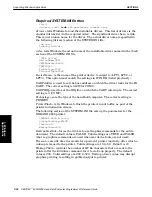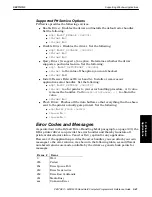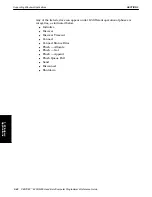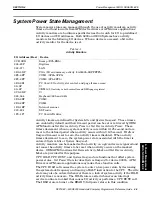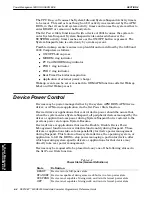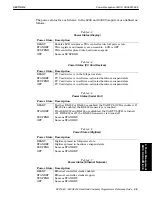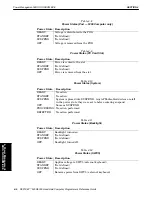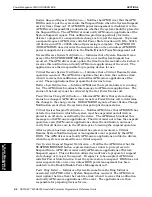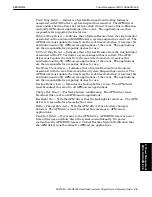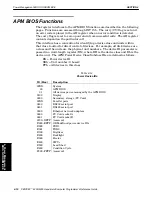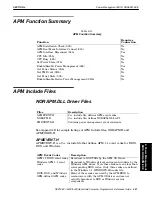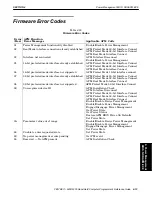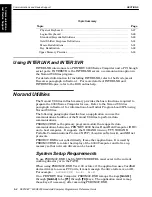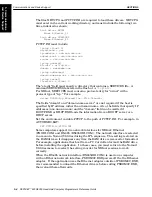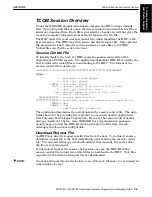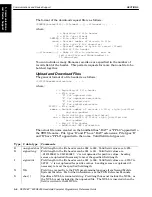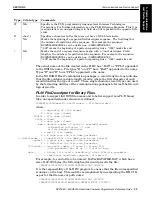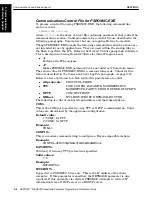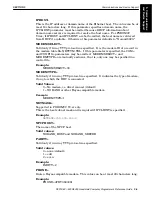
SECTION 4
Power Management BIOS: NORAPM.EXE
4-8 PEN*KEY
R
6200/6300 Hand-Held Computer Programmer’s Reference Guide
System Suspend Request Notification Ċ
Notifies the APM Driver that the APM
BIOS wants to put the system into the Suspend State when the System Suspend
activity timer times out. If APM BIOS power management is disabled, it is the
APM Driver's responsibility to determine whether the system should be placed in
the Suspend State. The APM Driver must notify APMĆaware applications of the
System Suspend request. This notification provides opportunity for device
drivers to prepare for a suspend state change or to reject the request. To process
a suspend request, APM Driver calls Set Power State function with BX = 0001h
(all devices) and CX = 0002h when all processing is complete. The APM BIOS
(NORAPM.EXE) does not enter the suspend state on its own unless APM BIOS
power management is enabled via the Enable/Disable Power Management call.
Normal Resume System Notification Ċ
Indicates that a System Resume from a
press of the SUSPEND/RESUME key after a normal System Suspend has
occurred. The APM driver must update the time from the realĆtime clock when it
receives this notification and notify APMĆaware applications of the event. The
applications are then responsible for preparing devices for use.
Critical Resume System Notification Ċ
Indicates that a Critical Resume System
operation occurred. The APM driver updates the time from the realĆtime clock
when it receives this notification and notifies APMĆaware applications of the
event. These applications then prepare their devices for use.
Battery Low Notification Ċ
Informs APM driver that system battery is running
low. The APM driver broadcasts this message to APMĆaware applications. The
status of the battery must be retrieved by the Get Power Status call.
Power Status Change Notification Ċ
Informs APM driver that system charge
status has changed. APM driver must issue Get Power Status call to determine
the change to the charge status. NORAPM.EXE signals a Power Status Change
Notification event when the system's charger input changes status.
Critical System Suspend Notification Ċ
Notifies APM driver that APM BIOS has
detected a situation in which the system must be suspended and all devices
placed in an off state, as defined by the device. The APM must broadcast this
message to all APMĆaware applications. The driver must not refuse the suspend
operation, even if APMĆaware applications refuse the notification, and must
verify that all devices are in the off state prior to issuing the suspend operation.
After a system has been suspended and the system is resumed, a Critical
Resume System Notification power management event is posted by the APM
BIOS. The APM driver must notify APMĆaware applications and device drivers
when the system is resumed from a critical suspend.
User System Suspend Request Notification Ċ
Notifies the APM driver that the
SUSPEND/RESUME button is pressed and user wants to put system into
Suspend State. APM driver must notify APMĆaware applications of System
Suspend request. This notification allows device drivers to prepare for suspend
state change or to reject the request. If request is to be accepted, APM driver
calls Set Power State function to set the system state to suspend. BIOS does not
enter suspend state on its own, unless BIOS power management has been
enabled via the Enable/Disable Power Management call.
Pod 1 Ring Detect Ċ
Indicates a System Resume from the Ring Indicator
associated with POD1 after a System Suspend has occurred. The APM driver
must update the time from the realĆtime clock when it receives this notification
and notify APMĆaware applications of the event. The applications are then
responsible for preparing devices for use.
4. Power Management
BIOS: NORAPM.EXE



